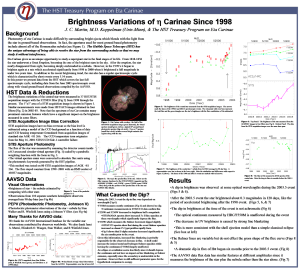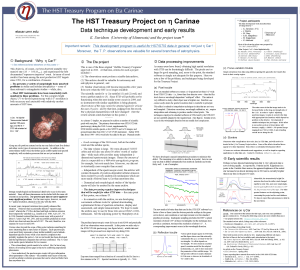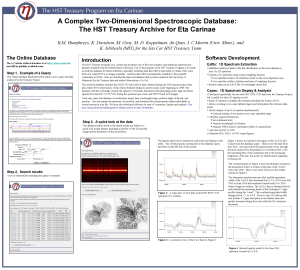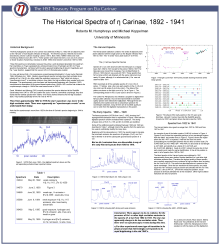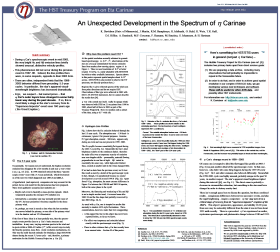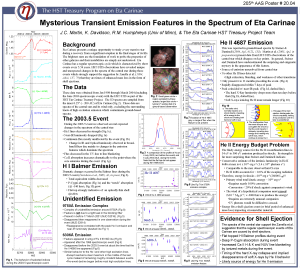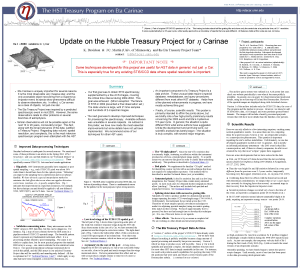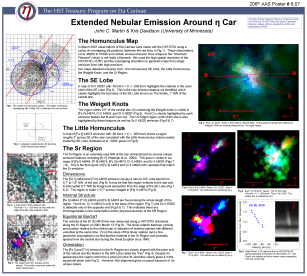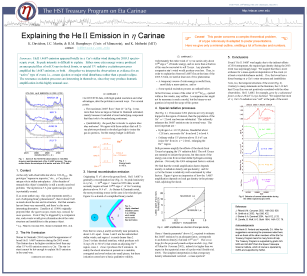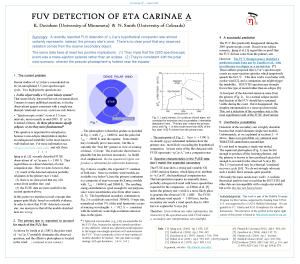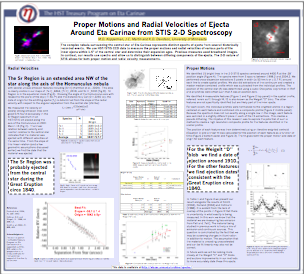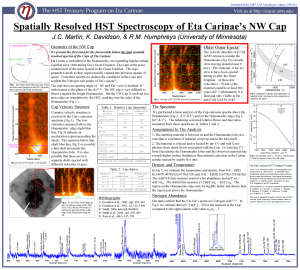Publications
This page contains papers, posters, talks, and internal technical reports authored by the Eta Carinae team at the University of Minnesota.
- Published papers
- Posters
- Technical memos (separate page)
HST Treasury Program Proposal (2001)
For a variety of reasons, HST can provide a very special and unique data set when Eta Car experiences its next spectroscopic event in mid-2003. Explaining the phenomenon is only part of the motivation. This star and its ejecta have unique characteristics that make them important for several branches of astrophysics; and when a spectroscopic event occurs, it's like varying the parameters in an experiment (or rather, set of experiments). The 2003 event will be the last chance in the forseeable future to obtain such a data set.
Eta Carinae has extreme parameters; it is mysterious in surprisingly basic ways; and HST/STIS can gather useful data on it at a terrific rate. As we explain below, the proposed data set will be valuable in several independent ways: It will help solve a specific set of current problems, it will constitute a large and unique archival data base for both stellar and nebular astrophysics, and it will be well-suited for educational uses.
Published papers
The Chrysalis Opens? Photometry from the Eta Carinae HST Treasury Project, 2002--2006
J. C. Martin, K. Davidson, M. Koppelman
Observed with 0.1-arcsec spatial resolution, the star has continued to brighten at an unprecedented rate. This probably represents either a reduced dust formation rate, or destruction of dust, or both; but indirectly some physical change of the wind is implicated. We suspect that the mass-loss rate may be decreasing on a timescale of only a few years. (The complex relation between the star's apparent brightness, and the brightness of the entire Homunculus observed from the ground, is not entirely understood.)
Variable Unidentified Emission Near 6307 AA in Eta Carinae
J. C. Martin, K. Davidson, F. Hamann, O. Stahl, K. Weis
The paper will appear in the May 2006 PASP. We discovered a conspicuous unidentfied emission feature near 6307AA in the spectrum of the central star. It is significant for two reasons: such prominent unidentified lines are now rare in this object, and this feature varies strongly and systematically. This line may be tied to both the spectroscopic cycle and the long-term brightening trend.
The 2005 HST Calibration Workshop
The following papers where presented by members of the Minnesota Treasury Project Team at the 2005 HST Calibration Workshop in Baltimore, MD.
- K. Davidson -- Some Neglected Pixel Problems
- J.C. Martin -- The Eta Carinae Treasury Project and the HST/STIS
On The He II Emission in Eta Carinae and the Origin of Its Spectroscopic Events
J.C. Martin, K. Davidson, R.M. Humphreys (University of Minnesota), D.J. Hillier (University of Pittsburg), & K. Ishibashi (MIT)
Published in the 2006 March 20 Astrophysical Journal. High excitation He II emission, anomalous in some respects, appeared during the 2003.5 spectroscopic event. Several of its characteristics strongly support an ejection or wind-disturbance model for the event and not an eclipse model. This is important because it probably indicates a surface instability, which if true, is a valuable clue to the star's structure.
A Change in the Physical State of Eta Carinae?
K. Davidson, J.C. Martin, R. M. Humphreys (University of Minnesota), K. Ishibashi (MIT), T. R. Gull (NASA/Goddard), O. Stahl, K. Weis (Ruhr-Universitat Bochum), D. J. Hillier (University of Pittsburg), A. Damineli (IAG - University of Sao Paulo), M. Corcoran (NASA/Goddard), F. Hamann (Univeristy of Florida)
A paper published in the February 2005 Astronomical Journal which describes the evolution of the Balmer emission line profiles in the central star over the last six years as observed by the HST STIS. We conclude from the observed changes that the central star of Eta Carinae may be entering a new phase of recovery from the 1850 Great Eruption.
Fate of the Most Massive Stars (Conference)
The following are papers presented by members of the University of Minnesota Eta Carinae Treasury Project Team at The Fate of the Most Massive Stars Conference held in Jackson Hole, WY in May 2004.
- J.C. Martin -- The Optical Variability of Eta Carinae Since 1950
- K. Davidson -- The Physical Nature of Eta Carinae
- R.M. Humphreys -- Eta Carinae - The Observational Story, 1600 to 2004
Eta Carinae: Early Results & STIS Techniques
Kris Davidson, University of Minnesota
The brief article mentions some of the improvements that we are making with regards to STIS processing techniques. These are potentially useful for observations of other objects.
“Eta Carinae's Brightness Variations Since 1998: HST Observations of the Central Star”
J.C. Martin, M.D. Koppelman (Univ. Minn), & The HST Treasury Program on Eta Carinae
A paper published in the April 2004 Astronomical Journal which details the brightness changes in the central star over the 1998-2003.5 spectroscopic cycle. We show that the central star has continued to brighten by some unknown mechanism at an acellerated pace.
“The Hubble Treasury Program on Eta Carinae”
Kris Davidson, University of Minnesota
This article was prepared for the Spring 2002 issue of the STScI Newsletter, which contained brief descriptions of the three original HST Treasury Programs.
Download PDFThree Essential pre-2004 Theoretical Overviews
- "Chandra meets Eta Carinae" - K. Davidson (ASP Chandra Workshop 2001)
- "Eta Carinae" - K. Davidson (Cosmic Explosions, Maryland Astrophysics Conference 1999)
- "Why the Binary Hypothesis Isn't a Panacea" - K. Davidson (Eta Car at the Millennium, 1998)

